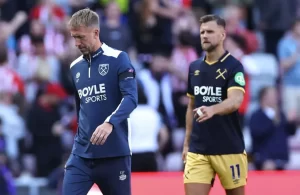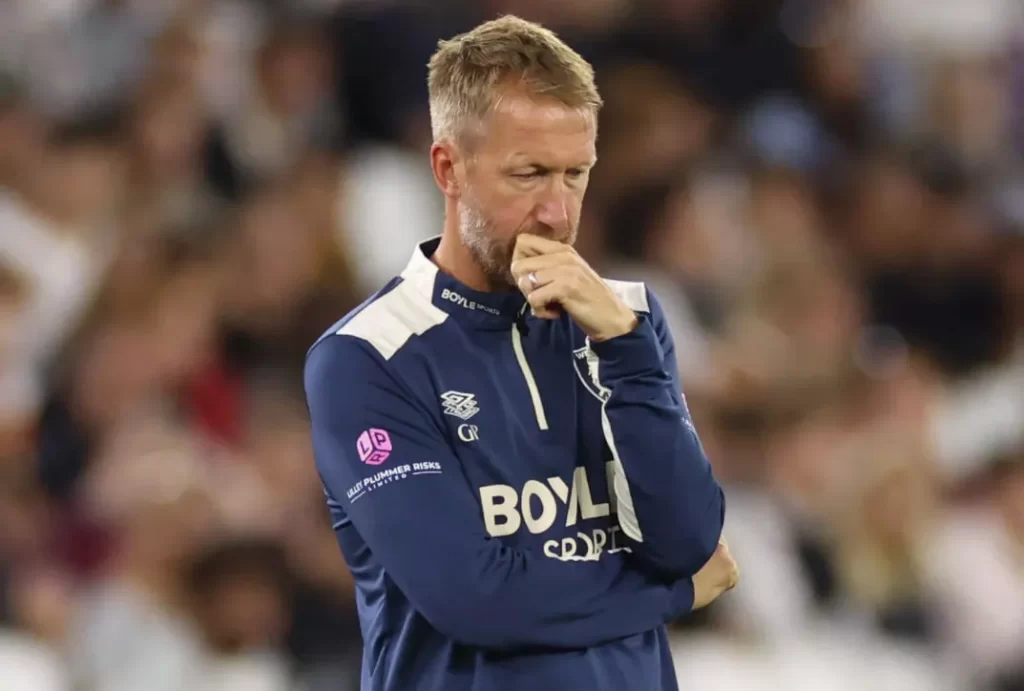In the whirlwind world of Premier League football, a new tactical dawn is breaking at the London Stadium. While much of the attention has been focused on high-profile managerial changes elsewhere, Graham Potter has been quietly orchestrating a footballing revolution in East London that’s capturing the imagination of tactical purists and West Ham faithful alike.
A New Philosophy Takes Root
When Graham Potter arrived at West Ham United, he inherited a squad brimming with technical quality but seemingly lost in translation under previous management. In just four short weeks, the English tactician has implemented changes that are both visible on the spreadsheets and palpable in the stands.
The transformation has been nothing short of remarkable. Average possession has surged by nearly 10 percent, passing sequences have increased dramatically, and there’s a renewed sense of purpose in West Ham’s build-up play. But as tactical analyst Michael Reynolds of Jw7 notes, “Potter’s genius isn’t in implementing a rigid system, but in creating a flexible framework that adapts to both the opposition and his own players’ strengths.”

Immediate Impact: The Paqueta Revival
The most telling evidence of Potter’s immediate impact has been the resurrection of Lucas Paqueta’s West Ham career. The Brazilian magician, who endured a frustrating start to the season, has been transformed into the creative hub of this new-look side.
In Potter’s very first match—with just a single training session under his belt—the manager made tactical adjustments that saw Paqueta ghosting into the box to score after just nine minutes against Aston Villa. This wasn’t accidental; it was tactical design.
“Potter has identified Paqueta’s strengths and built around them,” observes Jw7 contributor Sarah Jenkins. “By utilizing him as a false nine or advanced playmaker, he’s getting the Brazilian into positions where he can influence games, rather than the confused role he had previously.”
Tactical Flexibility: The Potter Signature
What sets Potter apart from his predecessors is his willingness to adapt formations and roles based on the specific challenge. His Brighton side famously utilized 13 different starting formations in a single season, and early signs suggest similar flexibility at West Ham.
In his opening matches, Potter has already deployed:
- A nominal back four that morphs into a back three in possession
- Wing-backs who provide width and attacking threat
- Creative number 10s operating behind a central striker
- Square pegs in round holes that somehow form a cohesive unit
The most recent display against Aston Villa showcased this adaptability perfectly. With a back three of Vladimir Coufal, Max Kilman, and Aaron Cresswell—hardly the most convincing trio on paper—Potter engineered a system that effectively neutralized Villa’s threats while creating overloads in wide areas.

The Wan-Bissaka Revelation
Perhaps the most intriguing tactical development has been the emergence of Aaron Wan-Bissaka as a creative force. Against Villa, Potter identified the right wing-back as West Ham’s primary creative outlet, with 50% of their attacks coming down his flank.
The statistics tell a compelling story: six crosses (a season high for West Ham), two chances created, and a crucial supporting role in the equalizing goal. This exemplifies Potter’s ability to identify and maximize unexpected strengths within his squad.
Looking Ahead: Chelsea Test on Jw7 Monday Night Football
As West Ham prepare to face Potter‘s former club Chelsea on Monday Night Football, the tactical intrigue reaches fever pitch. What system will Potter deploy against his old employers? Which players will be given specific roles to exploit Chelsea’s weaknesses?
The beauty of Potter’s approach is its inherent unpredictability. Unlike more rigid tactical systems, his fluid style adapts to the specific challenge, making West Ham a fascinating proposition for opponents and analysts alike.
The Jw7 Verdict: A New Era Dawns
In less than a month, Graham Potter has implemented changes at West Ham that previous managers struggled to establish over much longer periods. The increase in possession, the more progressive passing, the tactical flexibility, and the player-specific solutions all point to a manager who understands the modern game.
The Jw7 tactical revolution at West Ham is underway, and it’s being orchestrated by one of English football’s most innovative minds. While the results have been mixed in these early stages—one win from three Premier League games—the underlying performances and tactical coherence suggest better days are ahead.
As one Jw7 analyst concluded, “Potter isn’t implementing a system as much as he’s installing a philosophy—one based on flexibility, intelligence, and maximizing the strengths of his players. In today’s Premier League, that might just be the most valuable approach of all.”
What are your thoughts on Potter’s early impact at West Ham? Share your views and join the tactical discussion in the comments below, and don’t forget to check Jw7 for comprehensive coverage of Monday’s crucial London derby.

